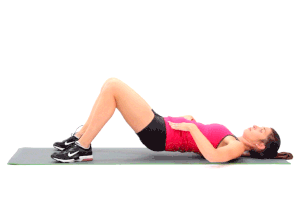Exercises to Make a Baby Drop During Pregnancy
In the last weeks of your pregnancy, you may notice increased pressure in the pelvic area. This is usually caused by your baby dropping into position. If your due date is right around the corner and your baby has not yet dropped into position, don't worry; some babies don't drop until labor begins. However, there are some helpful exercises you can do that encourage baby to drop while also preparing your body for labor and delivery. Avoid these exercises if your baby is in breech position, since they may make it more difficult for your baby to change into a head-down position.
Walking
Walking is a perfect exercise for pregnant women, particularly in the later trimesters. It is easy on the joints and provides a gentle aerobic workout, which can help control weight gain. Walking also opens the hips and relaxes the pelvic muscles, which can aid in the lightening process in the final weeks of pregnancy. Keep in mind that walking is considered moderate-intensity aerobic exercise. If you haven't been exercising during your pregnancy, start slowly. Walk for 10 minutes a day, and gradually increase to 20 or 30 minutes.
Birthing Ball

Exercises With an Exercise Ball to Help Induce Labor
Learn More
Using a birthing ball in the last weeks of pregnancy will encourage your baby to settle into the pelvis while also relieving pressure and increasing blood flow to the baby. According to the Arizona Doulas Organization and Birth Education Association, or ADOBE, pregnant women should sit on a birthing ball as much as possible in the last four to six weeks of their pregnancy. Not only do birthing balls help your baby drop, but they may also help him rotate into the most favorable position for delivery, which will decrease your chances of painful back labor.
Squatting
Squats increase the size of the pelvic opening, while also using gravity to help your baby descend into the pelvis. They also strengthen your legs and open the hips for labor. Use caution when squatting in the third trimester, especially if you haven't been exercising throughout your pregnancy. Do squats against a wall for added support and balance, or squat while sitting on a birthing ball to avoid falling or injuring yourself.
Pelvic Tilts

Yoga Positions That Increase Contractions
Learn More
Pelvic tilts should be done throughout pregnancy if possible. Pelvic rocking is a gentle way to encourage your baby to drop into the pelvis. It also strengthens and stretches all of the core muscles, and helps relieve pain in the lower back, which is especially common in the second and third trimesters. Pelvic tilts may help relieve nausea and indigestion that many women experience in the third trimester. To perform pelvic tilts, get on your hands and knees, with your hands directly below your shoulders. Gently tilt the pelvis forward and relax the lower back. Bring the pelvis back to a neutral position and repeat for about two to three minutes.
Related Articles
- "Expecting Fitness"; Birgitta Gallo; 2000
- Arizona Doulas Organization and Birth Education Association: Birth Balls
- What to Expect: Squat Exercises During Pregnancy
- "The Bradley Method Student Workbook"; Marjie, James and Jay Hathaway, AAHCC; 2010











